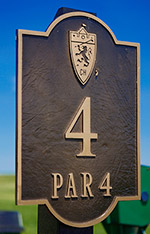 American golfers don’t often get to play a course without many trees, and when we do we often call the course “linksy.” Of course, nothing could be further from the truth, as true “links” land exists in only one place: right against a large body of water. Links land is a soft, fertile soil that literally “links” the inland sections to the body of water.
American golfers don’t often get to play a course without many trees, and when we do we often call the course “linksy.” Of course, nothing could be further from the truth, as true “links” land exists in only one place: right against a large body of water. Links land is a soft, fertile soil that literally “links” the inland sections to the body of water.
For treeless inland courses I prefer the term “early American.” Many of today’s parkland courses, characterized by chutes of trees leading from tee to green, began their lives as virtually treeless golf courses. Whether as a result of “Beautification Committees” or Mother Nature, treeless golf courses in 1930 became forested, heavily wooded courses by 2000. For example, Oakmont – home of this year’s U.S. Open – was once treeless and has had to remove some 8,000 trees to get back to its original look.
A short drive west of Oakmont, one will find an “early American” course in a town called “Cranberry.” Built on the top of a hill, Cranberry Highlands brings this style of architecture to a public, municipally owned course. I’ve had the chance to play Cranberry Highlands a few times, and I’ve come away with mixed feelings. Read on to see what I mean…
Conditions
Western Pennsylvania has had some unusual spring weather. In addition to a late snow, we’ve had cool, damp conditions that have done little to help local golf courses with their spring maintenance.
I’ve played Cranberry Highlands twice: once last September and most recently in late April for this review. The difference in conditioning was readily apparent. On my April visit, the grounds crew was out in full force clearing the plugs that had been pulled from the fairway a few days before. The greens still showed signs of being aerated recently and, due to the cool, damp conditions, were rolling rather slowly. Fairways were thin, the rough was spotty, and the fescue grass off the fairways had been cut rather short.
The September visit was more telling and more representative of the conditions one can expect at Cranberry Highlands (CH).

The Cranberry Highlands clubhouse contains a small pro shop and a lot of dining facilities.
In September, the greens were rolling at about ten on the stimp meter, typical for CH. (Players have no excuse for bad pace as the course has a large, two-tiered practice green with a variety of hole locations. A separate practice green is available for bunker shots, chips, and pitches.) The greens hold shots without being soft. As a new course, one would almost expect the USGA spec greens to be very hard, but the delicate balance found on CH’s greens between overly firm and overly soft is a testament to the grounds crew and the care they put into the greens.
The fairways are firm and the lies tight. While the firm soil will allow a good amount of roll, players who like a lot of grass under the ball may be a tad disappointed. CH is still a relatively new course, and the thick grass carpets that many players like on older courses take time to develop. To be clear: there are no brown spots, hardpan, or grassless patches. The grass is simply a bit thinner than you’ll find on older courses. The course will undoubtedly “flesh out” with time.
Just off the fairway, players will find rough typical of this area. It’s short – two or three inches only – but juicy and can grab a hosel or twist a club like nobody’s business. Balls can sit up, they can fall to the bottom, or they can find a lie somewhere between, and each requires a different strategy and shot to play successfully. If you’ve never experienced rough like this, I dare say it’s the shortest tough rough you’ll ever find.
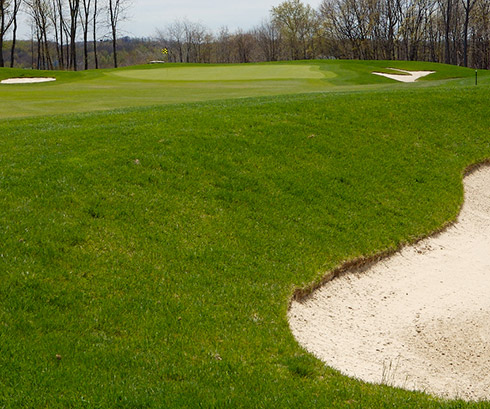
This shot of the approach to the second green shows off the job the maintenance crew has done in preparing the golf course for play despite the poor spring weather.
If your drives (or, heaven forbid, your approach shots) manage to miss fairway and the short rough, you’ll find yourself in the hay – literally. Though Cranberry Highlands is cutting this “fescue” type rough lately in order to speed up the pace of play, at times between mowings you’ll find foot-tall grasses that allow nothing more than a sideways pitch back to the fairway. This grass, combined with the lack of trees, simply adds to the “linksy” feel of the course.
I’m a stickler for consistent sand, but CH offers little to complain about in this regard. The bunkers offer reasonable lies and medium-firm sand. It’s a coarser sand than you’ll find at a lot of courses outside of the region, but a fine sand for golf. Think “Oakmont” more than “Augusta” and you’ll get it.
Though Cranberry Highlands is a municipal course, it isn’t the hardpanned, browned out, never watered muni dog track you may have grown up playing. Of course, CH is no Bethpage, either, but instead occupies a comfortable middle ground between abysmal and opulent.
Design and Layout
Cranberry Highlands is, true to its name, built on the top of one of several foothills. Given the treeless design, perhaps the most obvious and important feature at CH is the wind. Even a subtle breeze, unimpeded by forestation and whipping along the tops of the hills, can pose a problem for players unaccustomed to dealing with it. And on a day the pro shop employees call “windy,” well, batten down the hatches.
Cranberry Highlands may best be described as “straightforward” or “simple.” If you’re of a particularly dour mindset, “boring” might be the word you’d choose to describe it. Virtually every hole on the course is straightaway, with fairways devoid of twists and turns. The generous to average fairways accept either a fade or a draw on virtually every hole, and the lack of doglegs (save one) rewards no particular shot shape so long as the ball finds the short grass.
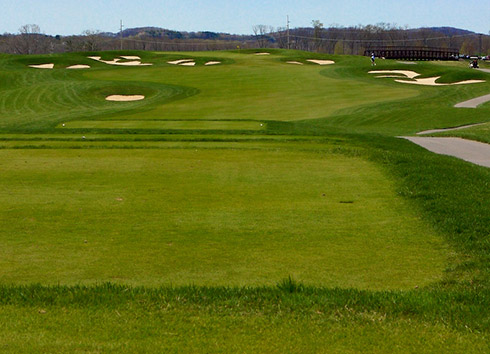
The short par-four 11th hole requires a good 3W and a crisp wedge to score. Anything less will be punished.
Though I personally wouldn’t classify Cranberry Highlands as “boring,” I can see how some players might. CH offers a solid if unspectactular test of golf that becomes more about what you make of it than what’s pushed on you. The setup allows for an American game – a high flying, high-spin, flop shot kind of game – or a more European style full of bump-and-runs, putts from well off the greens, and creativity galore.
The course’s holes become more interesting as the par decreases, so let’s start at the high end with the par fives. Each – the second at 561, the seventh at 549, and the 18th at 573 – plays about the same yardage, though the 18th will play a good bit longer as it is uphill and into the prevailing wind. All three play dead straight. All three have bunkers on both sides of the drive landing areas, bunkers pinching the area most players will hit to with their second shots, and greenside bunkers to protect the greens from 9-iron or wedge approach shots. CH’s par fives are, again, unspectacular.
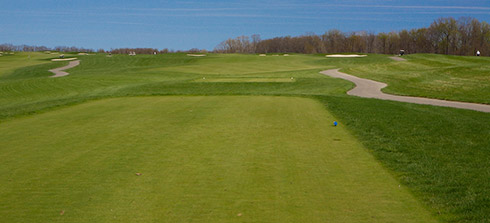
The 424-yard par-four 14th. Almost every par four and five offers a similar view from the tee. Ho hum. The 17th and 18th flank right and left, respectively.
The par fours don’t fare much better, with only a few holes standing apart from the rest. Three – the fourth at 415 yards, the 14th at 424, and the 17th at 438 – are remarkable only because of their length. Though 438 is hardly “long” these days, these three holes are the longest two-shot holes on the course. Again, they’re all straightaway, they all feature fairway and greenside bunkers, and they all dictate little or nothing in terms of shot shape or selection.
Your round at Cranberry Highlands begins on one of the straightaway par fours, this one measuring 344 yards. An incredibly generous fairway will leave all but the worst hooker, slicer, or topper with a wedge to a green devoid of much character. If you’ve had the chance to warm up, at least you can start with an easy par or birdie. The front nine concludes with an equally uninteresting hole, the 379-yard ninth, a very gentle dogleg right. The standout feature on this hole has to be the three-tiered green which readily accepts low run-up shots. The most interesting par four on the front may be the fifth, a 356-yard hole with a cross bunker right in the landing area. If you’re comfortable taking your drive to the right, you’ll leave yourself a short pitch to a flat, oval-shaped green. If you lay back with a three-wood or hybrid, you’ll probably only have a 7- or 8-iron to the flag.
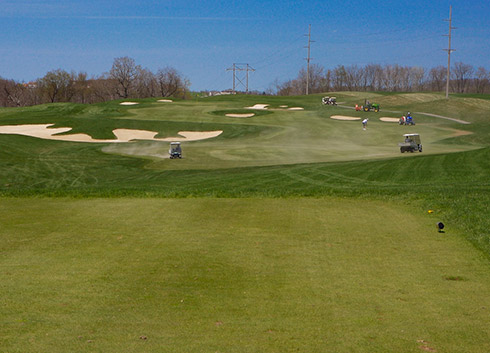
The fifth, seen here in the midst of fairway plug cleanup, is the most interesting par four on the front nine.
The back nine features the three most interesting par fours on the course. After the incredibly bland tenth, the 11th again offers a birdie chance if you’re capable of hitting a solid three-wood or bunting a driver into the fairway of the 322-yard hole before hitting a crisp wedge. The green, unlike most on the course, slants significantly back to front and is narrower than most. From the left side of the fairway where most drives collect, the green is angled back and left. Miss anywhere – off the fairway, long, left, or right of the green, and you can make six in a hurry. This short par four is a birdie opportunity that gives the golfer just enough rope with which to hang himself.
The 11th is followed by a 331-yard par four with more obvious trouble – water to the right. As the only par four with water, the 12th makes good use of the aqua. Because the hole measures only 331, the safe shot is with a hybrid off the tee, though players taking driver and aiming well left will still find they have a short iron to the green. The temptation, however, is strong, and the water – which should really be out of play for the most part – collects its fair share of surlyn and urethane pellets.
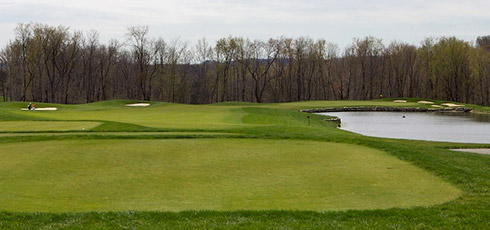
The tee shot at the 331-yard 12th looks more intimidating than it is: there’s plenty of room left.
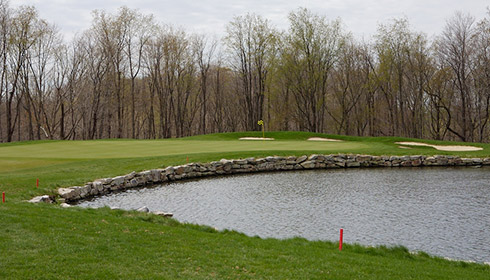
The 12th is the only par four with water (the only other is a par three). If you push your drive towards the water, this is your approach shot.
Finally, the 391-yard 16th is remarkable simply because it’s basically the only dogleg on the entire course. Bending hard to the left around two small bunkers, the hole begs the golfer to challenge the bunkers and to cut off every bit of the dogleg. This shot plays a bit of a trick on you, as the carry appears to be rather significant, but which measures only about 240 yards from the back tee. If you chicken out and bail right, you’ll likely leave yourself only an 8-iron in, as the far right side of the fairway is only 140 yards from the green.
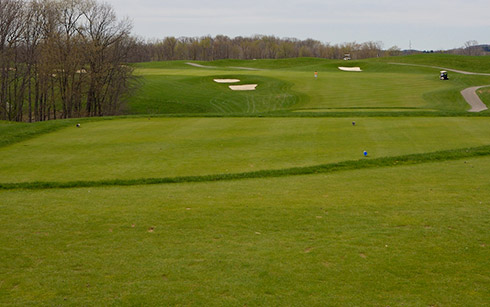
The tee shot at the 391-yard 16th will get the heart rate up for only the second time around Cranberry Highlands. Fortunately, it’s not as daunting – or long – as it looks.
For those who demand more excitement from their golf courses, Cranberry Highlands is saved a bit by the par threes, of which there are five. The sixth measures 194, plays downhill slightly, and features one heck of a pin position back left protected by a significant slope. The eighth measures 182 and appears rather unassuming from the tee, but the green is well protected and difficult to read.
On the back nine, the 13th plays 184 and is cut into a severe side slope. The prudent player errs to the left and short a bit, as anything right or long is likely to find a deep bunker or, worse, to bound down the slope and into the untamed forest surrounding the course. Finally, the 15th: a 218-yard hole over a deep chasm (the same you’re asked to carry on the 16th discussed just above). In my two trips to Cranberry Highlands, I’ve hit a hard hybrid and an easy five-iron to this hole due to the difference in tee position (back, up) and winds (against, with) each time. The round green is heavily sloped back to front, so once you reach the putting surface you still have a good bit of work to do.
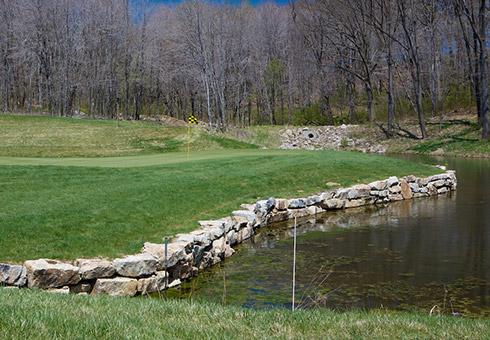
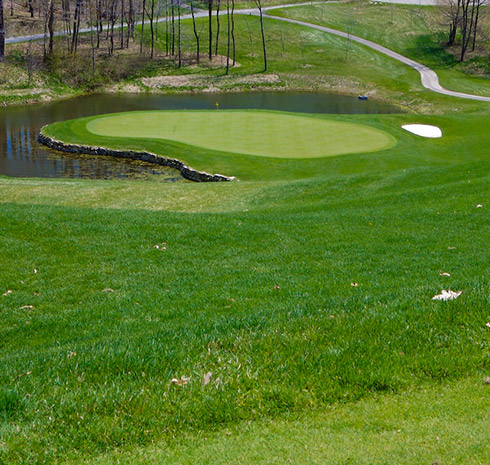
The interesting par-three third plays 191 yards but, as you can see here, is quite severely downhill. Still, club selection is of paramount importance with all that water!
I’ve saved the only other hole on the golf course capable of increasing your heart rate for last. The par-three third is listed at 194 yards and is bordered by water on two or three sides – back, left, a little front, and a little right. Despite its length, and though I’m not a long hitter, I’ve hit an easy 7-iron to the back of the green, as the hole also features a 100-foot drop from tee to green. The drop allows for a great view of the green and all the liquid around it. Chickens will be comforted by the little strip of fairway short and right, but those brave enough to go at the flag should take two to three clubs less and swing smoothly. The putting surface may be large, but there’s little margin for error.
Bang for the Buck
Cranberry Highlands will run the out-of-towner $49, including a cart, Monday-Thursday. Fridays, weekends, and holidays run $64. After 2:00pm, players can deduct $5 and $10 respectively. Cranbery residents pay only $39 Monday-Thursday (or $34 after 2:00) and $50 ($40) on Fridays, weekends, and holidays. Tee times can be booked well in advance.
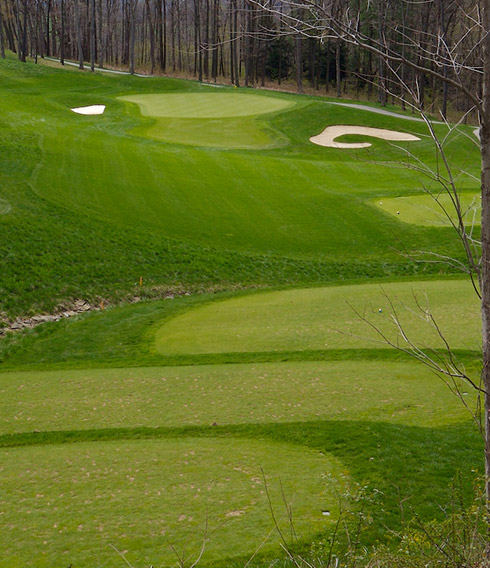
Missing right at the par-three 13th will indeed be unlucky. Err to the left – or short if you have to – to avoid a big number.
Except for the long walk from the third green to the fourth tee, Cranberry Highlands is not an exceptionally difficult course to walk. The tees are all reasonably close to the greens and elevation changes, though present, are more moderate than I’ve seen at other courses which allow walking. While Cranberry Highlands allows walking, it’s disappointing that the price structure discourages it.
These prices are pretty well on par with others in the area. Being so close to Pittsburgh, it’s quite easy to drive another 30 minutes, pay twice as much, and find a course not nearly as well conditioned. Cranberry residents have no excuse not to try the course, and it’s well worth a two- or three-hour drive for those interested in giving the track a try.
Conclusion
Call it simple. Call it straightforward. Heck, call it dull if you want. Cranberry Highlands can be all of those things – or something else entirely – because it is what you make of it. The course is not going to force any one style of play nor does it really favor any player. At 6444 yards and playing to a par of 70 from the back tees, Cranberry Highlands is not even incredibly long.
“The golf course,” one person I played with in September said, “is just there. What you do with it is up to you.” If you want to get creative, Cranberry Highlands can be thought of as a blank canvas. Work shots left and right, high and low. Play bump and runs. Play high flop shots. Use every club in your bag and every trick up your sleeve.

Stray from the short grass and Cranberry Highlands’ many bunkers await. These are left of the seventh fairway.
Except on days when the wind is really whipping and the hay between holes is allowed to grow, Cranberry Highlands has one big thing going in its favor: it’s a playable golf course in good shape. My second time around I was behind a guy who probably shot 250 if he had actually obeyed the Rules of Golf, but not once did I see him lose a ball, not once did he fail to carry some chasm. Not once did his ball ricochet off trees or plunk in a lake.
Cranberry Highlands is a playable golf course. I repeat it to emphasize the good in that statement, and without getting off on a rant about the “playability” of modern golf courses, what with their $150 greens fees and their excessive flashy bunkers and “water features,” to suggest that simple playability is not only a good thing, but a great thing in a golf course.
This course may not offer the bells and whistles of most modern courses, but deep down you’ll probably have a lot more fun playing it than you will a 7,000-yard course with many of the “features” that are at Cranberry Highlands.
Scorecard
Hole 1 2 3 4 5 6 7 8 9 Out Par 4 5 3 4 4 3 5 3 4 35 Cran 344 561 194 415 356 198 549 182 379 3178 Back 318 542 176 391 341 139 524 168 329 2928 Hdcp 15 1 7 5 11 17 3 13 9
Hole 10 11 12 13 14 15 16 17 18 In Par 4 4 4 3 4 3 4 4 5 35 Cran 385 322 331 184 424 218 391 438 573 3266 Back 366 304 320 169 405 181 369 419 560 3093 Hdcp 14 16 12 18 4 8 10 6 2
Totals Cranberry 69.9 130 6,444 yards Back 68.3 127 6,021 yards Middle 65.8 117 5,497 yards Forward 66.7 110 4,769 yards
Thanks for the review, I’m from Pittsburgh, and I read the post-gazette online, so I knew the course existed, and it was nice to have an extended review of the course.
It sound much like Old Trail, near me in virginia. http://www.oldtrailgolf.com (I have no financial interest in old trail, I just like the course)
Thanks for the review of Cranberry Highlands , i would tend to agree that the course is good , but not great , and i believe the price is way to high for this course , especially for a muni , my friends or i wont be playing there any time soon as there are better courses in the Pittsburgh area that cost less ..
Thanks for the review of Cranberry Highlands. About a year ago I posted a short description of the course along with a description of Mill Creek Golf Club up in Rochester NY. Here are some thoughts I have on the review, the course, and the responses.
I will agree with pretty much everything that Erik said about the course. The “raise your heartrate/this is an incredible looking hole” factor is low on the course. There aren’t many pictures you could take of the course that would make a great postcard or magazine cover, save the par three third. And yes, there aren’t many par fours that have serious length, and the par fives don’t provide a definite challenge.
My own thoughts (and some of them were stated by Erik) are as follows. Cranberry Highlands is a great course for the average golfer. It is playable for a 30 handicapper. Course maintenance is their specialty, and should be considered if played. The course is kept in meticulous shape. I just played the course on May 25th and there were no signs of aeration, the greens were rolling fast and true, and the rough/fescue were as advertised. The rough is exactly as described, almost innocent looking but potentially devastating. The fescue is growing in thick. While trying to pitch back out into the fairway on the par 5 7th, I wasted three strokes in the fescue–not trying to hit a hero shot, trying to pitch out. If you are a scratch golfer, and foolishly overly concerned with length, then don’t go here. You probably wouldn’t appreciate the manicured bunkers, the spotless greens, and the possibility to score anyway. Personally, I enjoy Cranberry Highlands.
It is now 64 dollars for outsiders. This is a bit pricey, but for only playing it 3-4 times a year, I find it worth the money. I don’t live in the Pittsburgh area, so I can’t comment on there being better courses in the area for less. To me, I’ll play it every time I visit my friends in Cranberry until it exceeds 70$.
Thanks for the review…
I played the course with a friend today. Pace of play was abysmal. Almost all of the groups on the course were twosomes, and I didn’t see a ranger. Virtually every tee had two to three groups at any given moment.
Wow…This is about as much information about a single course as I can absorb. Thanks much. I’m playing tomorrow evening with a few buds from work…I hope your advice and review help me out. Thanks again.
I’ve played this course on three occasions now. If you’re not a straight hitter this course can prove quite frustrating and difficult. However if you are a straight hitter this course is quite easy. The course is in very nice shape but the price is to high even as a resident. I average probably 300 on drives and it’s tough to find a course in the area that offers me a challege in length. Any suggestions ???
I like the course, but $64.00 is _very high_ for the area. Basically, players who do not reside in Cranberry are subsidizing the cheaper resident rate. It’s a pill I’m willing to swallow once or twice a year, but that’s it.
Well i agree the course is decent but its no country club, not worth the price that is charged with so many other courses around. For the money quicksliver is a better place to play
i have played the course 3 times since it is 15 minutes away from my house and i have loved it. the course is very easy and short which is good for me because i have horrible distance of the tee.
My only problem with the course is the 70$ price tag which if you play it three times it is equivalent to playing the us open course Oakmont which is also not far from where i live. over all this is a great course and i look forward to seeing you there.
I played cranberry highlands a few years ago when i had to go to pittsburgh for work. I agree with the review completely. there is nothing jaw dropping about the place, but it is a fun track to play. I particularly liked the par threes, which i thought were varied and well designed. I don’t remember the price i payed to play there, but if its at 70$ then its probably only worth a round or two a year.
What a great review- we’re moving there in a few weeks and I’m looking for players to pair up with- either there or nearby. I’m about an 18- and a senior. If interested- please contact me at degirolamo@rocketmail.com. Let’s tee ’em high and let ’em fly!